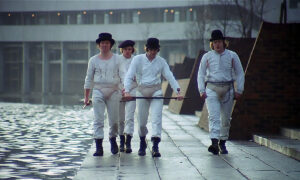When will Britain’s New Towns stop feeling so new? “Old Labour ideas are right for new times,” insisted Keir Starmer at party conference last year. Yesterday’s manifesto launch embodied this spirit: “A Labour government will build a new generation of new towns,” it declared.
But what of those that already exist? Once imagined as bastions of social democracy, many in the South East have, since the Seventies, been reliable bellwethers of broader national voting trends. Even today, despite Labour overstating the significance of their residents, the long story of New Town politics remains fascinating as much for what it reveals of the observers as of the observed.
Once conceived by the Labour government in 1946, 11 New Towns were designated in the first phase of construction, with eight forming a ring around London, intended to draw a population of almost 400,000 from a capital then considered dangerously overcrowded. The hopes expressed by Lewis Silkin, Minister of Town and Country Planning, in introducing the legislation seem impossibly utopian in these more jaded times. Silkin himself was unembarrassed in channelling Sir Thomas More and thought it “not unreasonable to expect that that Utopia of 1516 should be translated into practical reality in 1946”.
Silkin believed “neighbourhood units, each unit with its own shops, schools, open spaces, community halls and other amenities” (what we might call today a “15-minute city”) would bring people of all classes together. When, having attended some community facility or event together, New Town residents left to go home, he did “not want the better-off people to go to the right and the less well-off to go to the left. I want them to ask each other, ‘Are you going my way?’”. The true measure of New Town success, he said, would be “the kind of citizens they produce, by whether they create this spirit of friendship, neighbourliness and comradeship”.
Though Conservative critics may have felt differently, this was not ostensibly a party political appeal. Rather, it speaks to a short-lived moment in British politics when this old country was fundamentally reimagined and a new more rationally organised, socially just and classless society believed possible. It’s no spoiler to state that such extravagant hopes were destined for disappointment, but it’s worth dissecting both their trajectory and the thinking that underlay them.
Stevenage was the first New Town to be designated, in November 1946, and it was one built, more than literally, by its construction workers. Of the first 2,000 houses completed by the Development Corporation (all what we would now call social rented), over a quarter went to building workers and their families. This was a unionised workforce that came to take a leading role in tenants’ associations, community campaigns and local government.
By the Sixties, however, one perceives a certain ambivalence in attitudes towards Stevenage from some who had been its biggest supporters. Frederic Osborn and Arnold Whittick welcomed the New Town’s “dramatic societies, art clubs, horticultural and gardening societies, political groups, sports clubs for almost every sport, numerous women’s and youth organisations”, but somehow seemed less enamoured of the new Locarno ballroom and “American-style bowling hall”. They concluded:
“The people have had well-paid regular jobs in the factories and this has conduced to producing a feeling of contentment. It has enabled them to furnish their homes well, to acquire television, cars, and domestic gadgets, so that many who came as habitual grousers were transformed into contented citizens in a few years.”
Long before he became a celebrated socialist historian, a young Raphael Samuel, surveying attitudes in Stevenage that might explain Labour’s third consecutive general election defeat in 1959, lamented the “pattern of mass media-imposed misery” that apparently fuelled the acquisitive consumerism of many of his interviewees. This was reflected too in aspirations towards owner occupation; a 1966 survey found that 43% of Development Corporation tenants in Stevenage wanted to own their own home and 93% thought the Corporation should sell houses to sitting tenants. The popularity of Margaret Thatcher’s Right to Buy policy in the Eighties should come as no surprise.
All this played out to a backdrop of surprising nostalgia for what Michael Young and Peter Willmott (whose 1957 book, Family and Kinship in East London, provided one of its foundational texts) called the “sociable squash of people and houses, workshops and lorries” of the slum districts from which many New Town dwellers had relocated. Their move, the authors suggested, marked a shift from “a people-centred to a house-centred existence”. The implicit suggestion was that the working class was becoming literally and metaphorically domesticated.
Sociologists soon coined the term “the affluent worker”; the title of a major study of Luton workers published by John Goldthorpe et al in 1968. (Employment and lifestyle patterns in Luton were similar to those of nearby New Towns.) The notion that rising living standards would inevitably condition the working class to vote Conservative grew. A 1960 book, Must Labour Lose?, concluded pessimistically that it seemed, in the short term at least, that it must. Left-wing intellectuals talked of embourgeoisement, a belief that working people were adopting middle-class lifestyles and values.
But, of course, the Labour Party won the 1964 and 1966 general elections and Shirley Williams held the Stevenage constituency for Labour from 1964 to 1979. The reality was more complex — it always is. Dissecting the Stevenage data, Jon Lawrence found that “people’s ambition to ‘better’ themselves… was intertwined with an awareness that this was also a collective endeavour”. Goldthorpe et al concluded that “our affluent workers remain, in spite of their affluence, men who live by selling their labour power to their employers in return for wages”.
In other words, aspiration and self-improvement were not antithetical to working-class affiliations but central to them. There remains, however, a caveat. This was not necessarily the self-improvement that earnest liberal reformers and the more idealistic Labour politicians envisaged. Silkin’s speech had referred to New Town residents enjoying “amateur theatricals” or playing “their part in a health centre or community centre”. One infers, perhaps unfairly, from the words of Osborne and Whittick a faint disappointment that Stevenage residents had been so easily bought off by consumer baubles. The laudable drive to improve working-class conditions has very often been associated with a desire to “improve” the working class themselves according to more elite ideas of what constituted rational, respectable or worthy behaviour.
As to class — a felt sense of one’s socioeconomic status and position, it remained central to people’s lived experience. Hierarchy, a certain precarity even in the prosperous Sixties, remained defining. It encouraged working-class people to join a union; it disposed them to vote Labour when the party spoke most directly to their interests and values. At the time, the Conservatives were signed up to a broadly social democratic, post-war political consensus centred on full employment, a mixed economy and the National Health Service. To many working-class electors, there was no great betrayal in voting for a party pledged to sustain the progress made since 1945.
Twenty years on much had changed. The New Towns were older, somehow more ordinary, and subject to some of the same economic pressures that afflicted more traditional working-class areas. The post-war consensus had frayed and then been broken by the election of a New Right Conservative government in 1979 that was to hold office for eighteen years. “Basildon Man” — more often “Essex Man” — became the avatar of this shift. Basildon had been created a New Town in 1948 but, far from embodying the progressive ideals of its post-war foundation, it now came to represent pure Thatcherism. To advocates, such as Simon Heffer who coined the “Essex Man” phrase in 1990, these were people who had escaped what he described as “the nasty workers’ barracks” of the New Towns to pursue an unashamedly acquisitive and individualist lifestyle of material self-improvement. (Harry Enfield’s character “Loadsamoney” was their hostile caricature.) Critics echoed Heffer’s definition for the most part but saw only boorish vulgarity lacking redeeming features. This was “the affluent worker” gone very rogue. Both Basildon and Stevenage (under shifting boundaries) were securely Conservative from 1979 to 1997.
It takes perhaps another political stereotype to allow a more nuanced and sympathetic view of the politics in play here. Tony Blair introduced us to “Mondeo Man” in his 1996 speech to the Labour conference. He had met him, so he claimed, four years earlier “in the Midlands on an ordinary, suburban estate”, polishing his Sierra. (It became a Mondeo after Ford phased out its Sierra line.)
“His Dad always voted Labour, he said. He used to vote Labour too. But he’d bought his own house now. He’d set up his own business. He was doing quite nicely. “So, I’ve become a Tory”, he said… His instincts were to get on in life. And he thought our instincts were to stop him.”
“But that,” Blair continued, “was never our history or purpose.” In many ways, the New Labour project — like it or loathe it — was an attempt to persuade that man and a wider cohort of so-called C2 voters in skilled manual occupations that Labour was the party that both respected and best reflected their interests.
Basildon and Stevenage were Labour-held from 1997 to 2010, but have voted Tory ever since. After a run of four election defeats, Starmer’s project — aided greatly by the record of successive Conservative governments — has been to offer just that reassurance and promise again, now not only to “Stevenage Woman” (the “Fortysomething disillusioned suburban voters with little time for politics” once thought vital to Labour gains), but to a far wider swathe of voters who have seen their living standards fall and the public services on which they depend decimated. In this context, electorally, ideologically perhaps, the red meat of socialism is subordinate, even counterproductive.
The New Town programme — 32 developed between 1946 and 1996, now housing around 2.8 million people — was an astonishing achievement, a mark of government ambition and accomplishment that today seems almost unimaginable. That the more extravagant hopes placed in it were unfulfilled is unsurprising, but it reminds us that any politics predicated on myths of class identity and destiny — whether Marxist-inspired or more modestly socialist — is bound for failure. Labour’s job now, as it has always been, is to persuade working-class and middle-class voters to vote for it not out of virtue but out of self-interest. That perhaps is the real lesson of New Town politics.
Disclaimer
Some of the posts we share are controversial and we do not necessarily agree with them in the whole extend. Sometimes we agree with the content or part of it but we do not agree with the narration or language. Nevertheless we find them somehow interesting, valuable and/or informative or we share them, because we strongly believe in freedom of speech, free press and journalism. We strongly encourage you to have a critical approach to all the content, do your own research and analysis to build your own opinion.
We would be glad to have your feedback.
Source: UnHerd Read the original article here: https://unherd.com/



